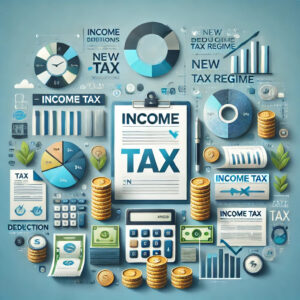Income Tax Structure Change
The new financial year is set to bring significant changes to India’s income tax structure. Starting April 1, 2025, taxpayers will witness key modifications in tax slabs, exemptions, and benefits. If you’re wondering how these changes impact your tax liability, here’s a detailed breakdown.
New vs. Old Tax Regime – What’s Changing ?
The government introduced the New Tax Regime (NTR) in 2020 as a simpler alternative to the existing Old Tax Regime (OTR). However, many taxpayers continued using the old system due to its various deductions and exemptions. From April 1, 2025, the tax structure will change to encourage more people to adopt the new tax regime.
Thank you for reading this post, don't forget to subscribe!

Key Changes in the New Tax Regime (Effective April 1, 2025)
✅ Lower Tax Rates – The new regime offers reduced tax rates compared to the old system, but without exemptions like HRA, LTA, and 80C.
✅ Higher Basic Exemption – The basic exemption limit is increased to ₹3 lakh under the new regime (compared to ₹2.5 lakh in the old system).
✅ Standard Deduction of ₹50,000 – Salaried individuals and pensioners can now avail a ₹50,000 standard deduction under the new regime.
✅ Higher Rebate Under Section 87A – Taxpayers with an annual income up to ₹7 lakh (previously ₹5 lakh) will not have to pay any tax under the new regime.
✅ Reduced Surcharge for High Earners – The highest surcharge on income exceeding ₹5 crore is reduced from 37% to 25%, lowering the effective tax rate.
✅ New Default Regime – The government has made the new tax regime the default system, but taxpayers can opt for the old regime if they prefer.
Old vs. New Tax Regime – Which One is Better ?
Old Tax Regime (OTR)
🔹 Allows Deductions & Exemptions – 80C, 80D, HRA, LTA, etc.
🔹 Higher Tax Slabs but potential tax savings via deductions
🔹 Best for individuals with high investments in tax-saving instruments
New Tax Regime (NTR)
🔹 Simpler & Lower Tax Rates
🔹 No exemptions/deductions required
🔹 Best for individuals with fewer tax-saving investments
| Income Slab | Old Tax Regime (With Deductions) | New Tax Regime (Without Deductions) |
|---|---|---|
| Up to ₹2.5 lakh | No Tax | No Tax |
| ₹2.5 lakh – ₹5 lakh | 5% (rebate under 87A) | 5% (rebate under 87A) |
| ₹5 lakh – ₹7.5 lakh | 20% (after deductions) | 10% |
| ₹7.5 lakh – ₹10 lakh | 20% | 15% |
| ₹10 lakh – ₹12.5 lakh | 30% | 20% |
| ₹12.5 lakh – ₹15 lakh | 30% | 25% |
| Above ₹15 lakh | 30% | 30% |

Who Should Choose Which Regime?
✔ Choose the Old Regime if you claim deductions under 80C (₹1.5 lakh), 80D (medical insurance), HRA, home loan interest, etc.
✔ Choose the New Regime if you don’t have major investments and want a hassle-free, lower tax rate structure.
Final Thoughts
From April 1, 2025, the Indian tax system will shift towards the new regime, making it the default choice for taxpayers. While the new tax regime is attractive for those seeking simplicity and lower rates, the old tax regime still benefits those who actively invest in tax-saving instruments.
Carefully evaluate your income, deductions, and financial goals before making a choice. Stay informed and consult a tax expert if needed!


